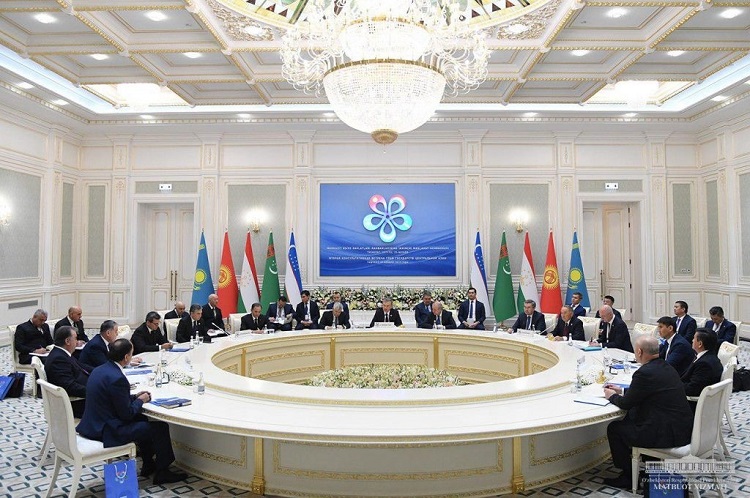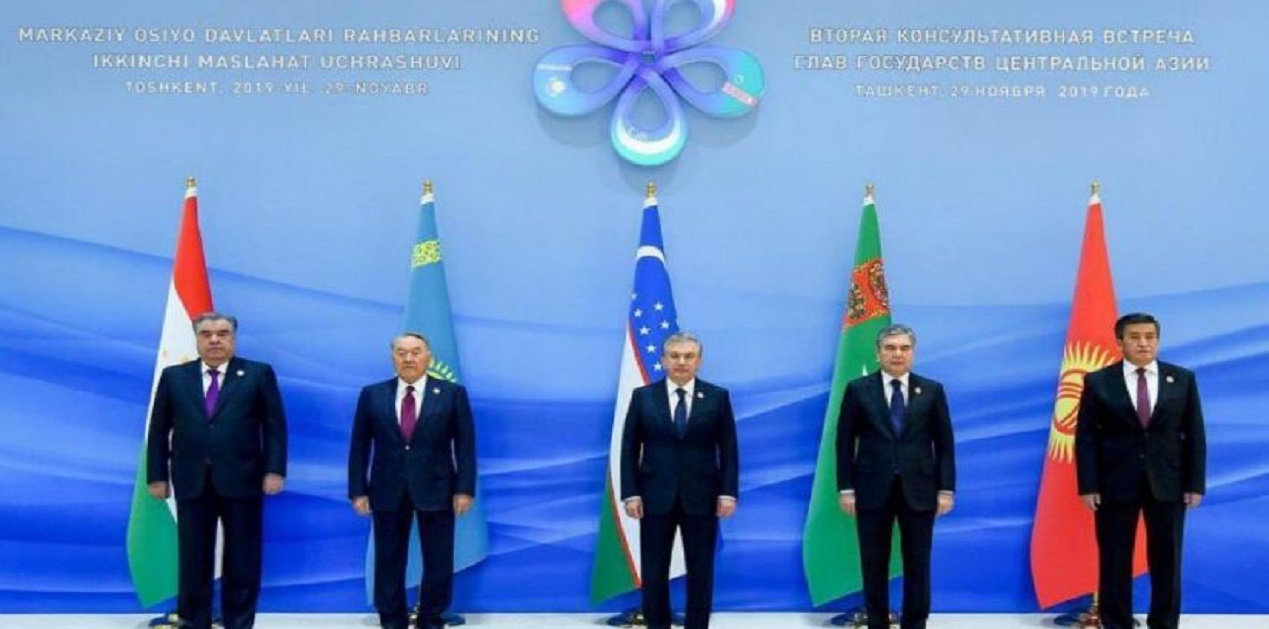Background
Uzbek President Shawkat Mirziyoyev’s efforts of re-channeling the regional cooperation among the Central Asian states seems to be fructifying lately. Since assuming power in December 2016, he garnered greater ambitions of getting all the Central Asian leaders on a single platform to discuss the issues of bilateral and regional importance, such as restoration of Aral Sea, water sharing, and border disputes.
In this direction, first ‘Consultative Meeting’ of the Heads of all the Central Asian Republics held in Nur-Sultan, capital city of Kazakhstan, on 15 March 2018. Uzbekistan’s President Shawkat Mirziyoyev, Kazakhstan’s President Nursultan Nazarbayev, President of the Kyrgyz Republic Sooronbai Jeenbekov, President of Tajikistan Emomali Rahmon and Chairman of the Mejlis of Turkmenistan Akja Nurberdyeva attended this meeting. The views exchanged by the leaders of the region were centered on developing cooperation in communication, trade and economy, connectivity and cultural and humanitarian aspects, which would be based on mutual trust and interest with particular emphasis on strengthening security and stability in the region.1
The Second ‘Consultative Meeting’ of the Central Asian leaders held on 29 November 2019 in Tashkent, Uzbekistan. A wide range of topics related to regional development and ways to smoothen bilateral and multifaceted transactions were discussed, and subsequently a variety of suggestions came out with the line of these discussions. The meeting was attended by the presidents of Kyrgyzstan, Tajikistan and Turkmenistan, as well as the First President of Kazakhstan Nursultan Nazarbayev.2
Significance
The second meeting acquired more significance than the earlier one because of two notable developments. Firstly, former President of Kazakhstan Nursultan Nazarbayev participated in this meeting instead of current President Kassym Jomart Tokayev. After Nazarbayev’s resignation as Kazakh President, he has been bestowed with multiple honorary acclamations in various international forums. He is the Elbasy (the Leader of the Nation) and leader of the ruling party (Nur Otan) of Kazakhstan. In May 2019, Eurasian Economic Union (EAEU) celebrated its fifth anniversary, where Nazarbayev was awarded the title of ‘Honorary Chairman of the Supreme Eurasian Economic Council.’ In October 2019, during the Turkic Council Summit in Baku, Azerbaijan, he was bestowed with the title of ‘Honorary Chairman’ of the Council. Therefore, his participation in this meeting has given greater validity and significance to the event.
Central Asian Leaders during the ‘Second Consultative Meeting’ in Tashkent

Secondly, unlike the first Consultative Meeting, Turkmenistan’s President, Gurbanguly Berdimuhamedov, participated in the second meeting. Moreover, Turkmenistan coming out of its policy of political isolation to support an intra-regional platform for dialogue and discussion gesticulated its readiness for regional integration.3 Both of these developments came as an added advantage to the ‘Uzbek Diplomacy’ and giving extra weight to the regional integration process in Central Asia.
The speech delivered by each of the Central Asian leaders at this event highlighted the significance and urgency of regional cooperation for the participant countries, respectively. All the five leaders undeniably underscored the value of regional cooperation and expressed their disposition to reinforce this. Cooperation among Central Asian countries to increase regional trade was high on agenda of this meeting. Kyrgyzstan’s President Sooronbay Jeenbekov expressed his distress on low volumes of intra-regional trade in Central Asia and proposed greater trade related enterprises with countries in the region. He emphasized the issues of intra-regional water usage and highlighted the impediments in free movement of people, goods, services and capital as an obstacle to intra-regional trade.4
Nazarbayev, in his speech proposed to conclude an agreement between five Central Asian countries based on friendliness and cooperation for the development of the region in the 21st century. This essential policy document should redirect the basic principles and objectives of regional cooperation. He also said that this agreement would also ensure the principle of mutual respect for the independence, territorial integrity and sovereignty of the five countries. Intending to enhance security in the region, there is a vital need to summon a meeting of the secretaries of the security councils of the Central Asian Republics in the following year, said Nazarbayev.6
The Tajik President suggested creating an ‘Investment Fund of Central Asia’ so that the most promising regional projects would not get delayed due to lack of funds. He also brought up the water issue as almost two-third of the Central Asian water originates from Tajikistan but recent depletion of glaciers is causing serious concerns.
Uzbekistan’s President Shawkat Mirziyoyev has initiated this policy of bringing Central Asian Republics closer in their security, economic and political affairs so that intra-regional issues would not become an obstabcle in the regional development process. In his official statement, he comprehensively focused on inducting multiple joint economic projects which would precisely benefit all the countries in the region. He stressed on capturing regional advantages when countries negotiate individual business, energy and tourism-related projects. The China-Kyrgyzstan-Uzbekistan railway plan, which is also being funded by Central Asian countries is a significant project under China’s Belt and Road Initiative (BRI). It is considered to be an important regionl transport initiative that has been brought up several times by more than one leader during the meeting. This project has been delayed due to indecision arising from Kyrgyzstan however, Uzbekistan seems determined to give it a speedy progression. Uzbek President also reassured the Central Asian leaders that the consultative meetings will take place on a regular basis without transmuting into a regional organization.6
Turkmenistan’s President in his speech reiterated its willingness to cooperate with other frontline Central Asian states in reconstruction and peacebuilding of Afghanistan. He stated that “A key condition for the political stabilization, economic and social reconstruction of Afghanistan, its successful integration into regional and world economic processes is the implementation of major infrastructure projects with Afghanistan’s participation, primarily in such vital areas as energy, transport and communications.”7 He also proposed to establish a five-country Business Council to enhance the economic partnership between them.
All the five leaders unanimously agreed that Bishkek, capital city of Kyrgyzstan, would host the next Consultative meeting of the heads of Central Asian states in 2020.
Conclusion
Regional dialogue to revamp the effective cooperation mechanism between the Central Asian Republics is fundamental for terminating the long-standing regional divisions. Since the collapse of the Soviet Union, Central Asian countries have disregarded the need for formulating a regional development model based on mutual trust, which has hindered the progression and sustainability and paved the way for more significant challenges in their political, economic and security arenas. Therefore, it is highly required for the Central Asian leaders to go against their ambitions and desire to exhibit their peculiarities to the world in order to solve the issues pertinent to the future of the region.
Although, to this point, the first and second ‘Consultative Meetings’ have been symbolic, where the Central Asian leaders pull alongside each other on a common platform. However, in a broader context, these meetings have allowed the respective leaders to refashion their visions for the region to disseminate a broader and multiplied geopolitical assertion across the world. There is also a possibility that the long-pending regional issues of trade, water, and transportation will continue to dominate these meetings. However, it is also possible that they might come up with concrete outcomes for an enhanced regional integration if they keep meeting at regular intervals. As of now, these countries have restrained themselves from bringing up disagreeable issues with an intention to leave them for bilateral dealings.
References:
- ‘Presidents of Central Asia Held Consultative Meeting’, Caspian Policy Centre, 16 march 2018. https://www.caspianpolicy.org/presidents-of-central-asia-held-consultative-meeting/
- ‘Uzbekistan hosts second summit of Central Asia states’, Times of Central Asia, 30 November 2019. https://www.timesca.com/index.php/news/21873-uzbekistan-hosts-second-summit-of-central-asia-states
- Temirov A (2019), ‘Meeting of the Heads of the Central Asian Countries in Tashkent: For the Sake of Growing Friendship’, https://cabar.asia/en/meeting-of-the-heads-of-the-central-asian-countries-in-tashkent-for-the-sake-of-growing-friendship/?fbclid=IwAR3yARDYI-7fs1BdSpHkbtiUNgwZSR4w910RE1Sa7m9QKrtGRJRJGaALWBs
- Umida Hashimova (2019), “Central Asian Presidents’ Second Consultative Meeting Zooms in on Water, Trade, and Regional Cooperation”, The Diplomat, 2 December 2019. https://thediplomat.com/2019/12/central-asian-presidents-second-consultative-meeting-zooms-in-on-water-trade-and-regional-cooperation/
- Temirov A (2019), ‘Meeting of the Heads of the Central Asian Countries in Tashkent: For the Sake of Growing Friendship’, https://cabar.asia/en/meeting-of-the-heads-of-the-central-asian-countries-in-tashkent-for-the-sake-of-growing-friendship/?fbclid=IwAR3yARDYI-7fs1BdSpHkbtiUNgwZSR4w910RE1Sa7m9QKrtGRJRJGaALWBs
- ‘Regional cooperation in Central Asia and Uzbekistan’s role’, German Council on Foreign Relations, 16 Januray 2019. https://dgap.org/en/events/regional-cooperation-central-asia-and-uzbekistans-role
- ibid.
(The paper is the author’s individual scholastic articulation. The author certifies that the article/paper is original in content, unpublished and it has not been submitted for publication/web upload elsewhere, and that the facts and figures quoted are duly referenced, as needed, and are believed to be correct). (The paper does not necessarily represent the organisational stance... More >>
Image Source: http://www.eias.org/wp-content/uploads/2019/11/EKiD7-uX0AEBi-O-825x460.jpg











Post new comment